Determining Performance, Economic, and Environmental Benefits of Pavement Preservation Treatments: Results from a Systematic Framework for PMS
Abstract
1. Introduction
2. Objective and Scope of Work
3. NCAT and MnROAD Pavement Preservation Group Study
4. Preliminary Assessment and Treatment Performance Models
4.1. Preliminary Assessment and Data Exploration
4.2. Performance Modeling and Derived Benefits
- Treatment = treatment indication (0 = control (untreated), and 1 = treatment).
- Time = section service time (years).
- = overall intercept (average ln (IRI) for the control group and immediately after treatment application measurements).
- = average rate of change in ln(IRI) per unit of time for the reference group (control).
- = difference in baseline ln(IRI) between the reference (untreated) and the treatments in question, at time = 0 post-treatment.
- treatment group-specific deviation in baseline ln(IRI) from the overall .
- treatment group-specific deviation in rate of deterioration .
- k = 0.0157828, calibration factor for converting the IRI from in/mi to m/km (model calibrated in imperial units).
5. Economic Benefits and User Costs
5.1. Pavement–Vehicle Interaction Models (PVI) and Input Limitations
5.2. Life Cycle Cost Analysis: A Case Study
6. Emissions Reductions from User Stage
7. Conclusions
- In terms of performance and for wet freeze zones, treated sections maintained smoother surfaces longer than untreated sections (lower deterioration rates compared to control), confirming the effectiveness of preservation strategies in maintaining pavement smoothness over time. Further research is needed to explore treatments in no-freeze regions and integrate these findings with pavement-vehicle interaction models.
- Initial conditions and site-specific factors are critical in determining treatment impact. Variations in pretreatment IRI, traffic composition, and structure condition significantly influence the magnitude of benefits, reinforcing the need for context-specific performance expectations and the fundament of treating pavements while in “Good” condition.
- Improved smoothness resulted in reduced EFC on treated sections compared to untreated controls. This effect is especially pronounced on high-volume roads, where smoother surfaces reduced rolling resistance, translating into meaningful fuel savings for the road users. This supports the idea of also targeting preservation on high-volume roads, which can maximize the return on investment by the rapid accumulation of savings over the treatment life cycle. On low-volume networks, benefits accumulate at a slower pace when just considering EFC.
- In conclusion, a theoretical case study demonstrated that applying preservation treatments, such as micro surfacing, provides a cost-effective procedure when compared to untreated scenarios. LCCA showed that selected preservation treatments reduced user costs by 54–57% due to lower excess fuel consumption, particularly in high-traffic corridors. Accounting for factors such as agency treatment options and alternative user costs would enhance decision-making and refine the selection of pavement preservation strategies.
- Environmental benefits are a direct outcome of maintaining smoother pavements, with lower excess of GHG emissions during the user stage resulting from improved fuel efficiency. The disproportionate share of emissions from truck traffic emphasizes the potential for substantial CO2e reductions (over 60% relative reductions for the case study) in high-volume roads when preservation is applied proactively.
Author Contributions
Funding
Data Availability Statement
Conflicts of Interest
References
- Adlinge, S.S.; Gupta, A.K. Pavement Deterioration and Its Causes. IOSR J. Mech. Civ. Eng. 2018, 2, 9–15. Available online: https://www.iosrjournals.org/iosr-jmce/papers/sicete(civil)-volume6/60.pdf (accessed on 25 July 2025).
- Bektas, F.; Smadi, O.; Nlenanya, I. Pavement Condition: New Approach for Iowa Department of Transportation. Transp. Res. Rec. 2015, 2523, 40–46. [Google Scholar] [CrossRef]
- Papagiannakis, A.; Gharaibeh, N.; Weissmann, J.; Wimsatt, A. Pavement Scores Synthesis; Report: FHWA/TX-09/0-6386-1; Texas Transportation Institute, The Texas A&M University System: College Station, TX, USA, 2009. [Google Scholar]
- Peskhin, D.; Ram, P.; Zimmerman, K.; Pai, S. Pavement Preservation Program Benchmarking; Report: FHWA-HIF-24-024; Applied Pavement Technology, Inc.: Champaign, IL, USA, 2024. [Google Scholar]
- Zhou, Q.; Okte, E.; Al-Qadi, I.L. Predicting Pavement Roughness Using Deep Learning Algorithms. Transp. Res. Rec. 2021, 2675, 1062–1072. [Google Scholar] [CrossRef]
- Haddadi, S.; Coleri, E.; Wruck, B. A Network-Level Decision Making Tool for Pavement Maintenance and User Safety. 2017. Available online: https://rosap.ntl.bts.gov/view/dot/63421 (accessed on 25 July 2025).
- Ghosh, L.; Abdelmohsen, A.; El-Rayes, K.; Ouyang, Y. Temporary Traffic Control Strategy Optimization for Urban Freeways. Transp. Res. Rec. 2018, 2672, 68–78. [Google Scholar] [CrossRef]
- Grant, M.; Anne, C.; Pederson, L. Assesment of Greenhouse Gas Analysis Techniques for Transportation Projects. Transp. Res. Record. 2008. Available online: https://trid.trb.org/View/848709 (accessed on 1 September 2025).
- Environmental Protection Agency (EPA). Greenhouse Gas and Energy Consumption Rates for Onroad Vehicles in MOVES4; EPA-420-R-23-026; Environmental Protection Agency: Washington, DC, USA, 2023. Available online: https://nepis.epa.gov/Exe/ZyPDF.cgi?Dockey=P10186RQ.pdf (accessed on 25 July 2025).
- Hajj, E.; Loria, L.; Sebaaly, P. Performance evaluation of asphalt pavement preservation activities. Transp. Res. Rec. 2010, 2150, 36–46. [Google Scholar] [CrossRef]
- Bryce, J.; Rada, G.; Hicks, G. Effect of preservation treatments on pavement performance. In Pavement and Asset Management; CRC Press: Boca Raton, FL, USA, 2019; pp. 619–626. [Google Scholar]
- Wang, H.; Al-Saadi, I.; Lu, P.; Jasim, A. Quantifying greenhouse gas emission of asphalt pavement preservation at construction and use stages using life-cycle assessment. Int. J. Sustain. Transp. 2020, 14, 25–34. [Google Scholar] [CrossRef]
- Jia, Y.; Dai, X.; Wang, S.; Gao, Y.; Wang, J.; Zhou, W. Evaluation of long-term effectiveness of preventive maintenance treatments using LTPP SPS-3 experiment data. Constr. Build. Mater. 2020, 247, 118585. [Google Scholar] [CrossRef]
- Poor, N.; Braham, A. Road Use Contributions to Energy Consumption and Greenhouse Gas Emissions for Two Flexible Pavement Maintenance Strategies. J. Test. Evaluation 2023, 51, 2210–2229. [Google Scholar] [CrossRef]
- Okwuenu, C.; Elbagalati, O.; Dylla, H.; El-Hakim, M.; Souliman, M.; Elwardany, M. Assessment of the role of pavement preservation in extending service life using the LTPP database. Can. J. Civ. Eng. 2025, 52, 946–957. [Google Scholar] [CrossRef]
- Wang, T.; Lee, I.S.; Harvey, J.; Kendall, A.; Lee, E.B.; Kim, C. UCPRC Life Cycle Assessment Methodology and Initial Case Studies for Energy Consumption and GHG Emissions for Pavement Preservation Treatments with Different Rolling Resistance; UC Davis; University of California Pavement Research Center: Davis, CA, USA, 2012. [Google Scholar]
- Vargas-Nordbeck, A.; Geib, J.; Worel, B.; Powell, B.; Ulring, J. Findings From the Pavement Preservation Group (PG) Study. 2024. Available online: https://eng.auburn.edu/research/centers/ncat/files/technical-reports/rep24-02.pdf (accessed on 24 July 2025).
- Sayers, M. Profiles of Roughness, Transportation Research Record 1260; Transportation Research Board, National Research Council: Washington, DC, USA, 1990. [Google Scholar]
- Federal Highway Administration (FHWA). National Performance Management Measures. In Assessing Pavement Condition for the National Highway Performance Program and Bridge Condition for the National Highway Performance Program; Federal Register: Washington, DC, USA, 2017; Volume 82, pp. 5886–5970. [Google Scholar]
- Qian, J.; Jin, C.; Zhang, J.; Ling, J.; Sun, C. International Roughness Index Prediction Model for Thin Hot Mix Overlay Treatment of Flexible Pavements. Transp. Res. Rec. J. Transp. Res. Board 2018, 2672, 7–13. [Google Scholar] [CrossRef]
- Vargas-Nordcbeck, A.; Brenes-Calderón, A. Effect of Mill and Thin Overlays on Roughness for Pavements in Cold Climate Locations. Transp. Res. Rec. 2022, 2676, 202–215. [Google Scholar] [CrossRef]
- Smeeton, N.; Spencer, N.H.; Sprent, P. Applied Nonparametric Statistical Methods; CRC Press: Boca Raton, FL, USA, 2025. [Google Scholar]
- Chen, C.; Deng, Y.; Li, M.; Shi, X. Investigation of key climatic factors affecting asphalt pavement roughness in different climate regions. Transp. Res. Part D Transp. Environ. 2023, 122, 103877. [Google Scholar] [CrossRef]
- Carvalho, R.; Ayres, M.; Shirazi, H.; Selezneva, O.; Darter, M. Impact of Design Features on Pavement Response and Performance in Rehabilitated Flexible and Rigid Pavements. 2011; Publication No. FHWA-HRT-10-066. Available online: https://rosap.ntl.bts.gov/view/dot/23591 (accessed on 25 July 2025).
- Horak, E. Benchmarking the structural condition of flexible pavements with deflection bowl parameters. J. S. Afr. Inst. Civ. Eng. 2008, 50, 2–9. [Google Scholar]
- Jalali, F. Quantifying Pavement Preservation Performance Using Probabilistic Deterioration Modeling. Ph.D. Thesis, Auburn University, Auburn, AL, USA, 2020. [Google Scholar]
- Fitzmaurice, G.; Laird, N.; Ware, J. Applied Longitudinal Analysis, 2nd ed.; Wiley: Hoboken, NJ, USA, 2011. [Google Scholar]
- Federal Highway Administration (FHWA). Status of the Nation’s Highways, Bridges, and Transit: Conditions and Performance, Report to Congress; Report FHWA-PL-08-017; Federal Highway Administration: Washington, DC, USA, 2001. [Google Scholar]
- Baladi, G.Y.; Prohaska, M.; Thomas, K.; Dawson, T.; Musunuru, G. Pavement Performance Measures and Forecasting and the Effects of Maintenance and Rehabilitation Strategy on Treatment Effectiveness (No. FHWA-HRT-17-095; HRDI-30/09-17 (400) E); Federal Highway Administration: Washington, DC, USA, 2017. [Google Scholar]
- Irfan, M.A. Framework for Developing Optimal Pavement Life-Cycle Activity Profiles. Ph.D. Thesis, Purdue University, West Lafayette, IN, USA, 2010. [Google Scholar]
- Brenes-Calderón, A.; Vargas-Nordcbeck, A. Use of chip seal treatments to mitigate pavement roughness progression in cold regions. Int. J. Pavement Eng. 2023, 24, 2241963. [Google Scholar] [CrossRef]
- Mohanraj, K.; Merritt, D. Use of Pavement–Vehicle Interaction-Related Models to Estimate Excess Fuel Consumption of Pavement Alternatives During the Design Stage. Transp. Res. Rec. 2023, 2677, 104–112. [Google Scholar] [CrossRef]
- Vistine, B.; Hicks, G.; Cheng, D.; Elkins, G. Factors Affecting the Performance of Pavement Preservation Treatments. In Proceedings of the 9th International Conference on Managing Pavement Assets (ICMPA9), Washington, DC, USA, 18–21 May 2015. [Google Scholar] [CrossRef][Green Version]
- Chatti, K.; Zaabar, I. Estimating the Effects of Pavement Condition on Vehicle Operating Costs; NCHRP Report 720; National Academies Press: Washington, DC, USA, 2012. [Google Scholar][Green Version]
- Rosta, S.; Gáspár, L. Skid Resistance of Asphalt Pavements. Eng 2023, 4, 1597–1615. [Google Scholar] [CrossRef]
- N-Sang, S.; Medina, J.; Kaloush, K. Integrating Flexible Pavement Surface Macrotexture to Pavement Management System to Optimize Pavement Preservation Treatment Recommendation Strategy. In Advances in Road Infrastructure and Mobility, Proceedings of the 18th International Road Federation World Meeting and Exhibition, Dubai, United Arab Emirates, 7–10 November 2021; Sustainable Civil Infrastructures; Springer Science and Business Media B.V.: Berlin/Heidelberg, Germany, 2022; pp. 735–752. [Google Scholar] [CrossRef]
- Bryce, J.; Santos, J.; Flintsch, G.; Katicha, S.; Mcghee, K.; Ferreira, A. Analysis of rolling resistance models to analyze vehicle fuel consumption as a function of pavement properties. In Asphalt Pavements, Proceedings of the International Conference on Asphalt Pavements, ISAP, Raleigh, NC, USA, 1–5 June 2014; CRC Press: Boca Raton, FL, USA, 2014; p. 1. [Google Scholar] [CrossRef]
- Mohanraj, K.; Merritt, D.; Sivaneswaran, N.; Dylla, H. Parametric and sensitivity analysis of PVI-related surface characteristics models for fuel consumption. In Advances in Materials and Pavement Performance Prediction II; Taylor & Francis Group: London, UK, 2020; ISBN 978-0-367-46169-0. [Google Scholar]
- Federal Highway Administration (FHWA). Federal Size Regulations for Commercial Motor Vehicles; Federal Highway Administration: Washington, DC, USA, 2004. [Google Scholar]
- RoadResource.org. Pavement Life Cycle Cost Analysis Calculator. Retrieved. 2025. Available online: https://roadresource.org/network/lc_calc (accessed on 10 August 2025).
- Pittenger, D.; Gransberg, D.; Zaman, M.; Riemer, C. Stochastic Life-Cycle Cost Analysis for Pavement Preservation Treatments. Transp. Res. Rec. 2012, 2292, 45–51. [Google Scholar] [CrossRef]
- Harvey, J.; Butt, A.; Lozano, M.; Kendall, A.; Saboori, A.; Lea, J.; Kim, C.; Basheer, I. Life Cycle Assessment for Transportation Infrastructure Policy Evaluation and Procurement for State and Local Governments. Sustainability 2019, 11, 6377. [Google Scholar] [CrossRef]
- Colvile, R.; Hutchinson, E.; Mindell, J.; Warren, R. The transport sector as a source of air pollution. Atmos. Environ. 2001, 35, 1537–1565. [Google Scholar] [CrossRef]
- Environmental Protection Agency (EPA). GHG Emission Factors Hub. 2024. Available online: https://www.epa.gov/climateleadership/ghg-emission-factors-hub (accessed on 25 July 2025).
- Environmental Protection Agency (EPA). New Fuel Economy and Environment Labels for a New Generation of Vehicles; EPA: Washington, DC, USA, 2011. [Google Scholar]
- Environmental Protection Agency (EPA). Fast Facts: U.S. Transportation Sector GHG Emissions 1990–2022; Environmental Protection Agency: Washington, DC, USA, 2024. [Google Scholar]
- Chehovits, J.; Galehouse, L. Energy Usage and Greenhouse Gas Emissions of Pavement Preservation Processes for Asphalt Concrete Pavements. In Proceedings of the First International Conference on Pavement Preservation, Newport Beach, CA, USA, 13–15 April 2010; Federal Highway Administration: Washington, DC, USA, 2010; pp. 27–42. Available online: https://www.pavementpreservation.org/icpp/paper/65_2010.pdf (accessed on 25 July 2025).
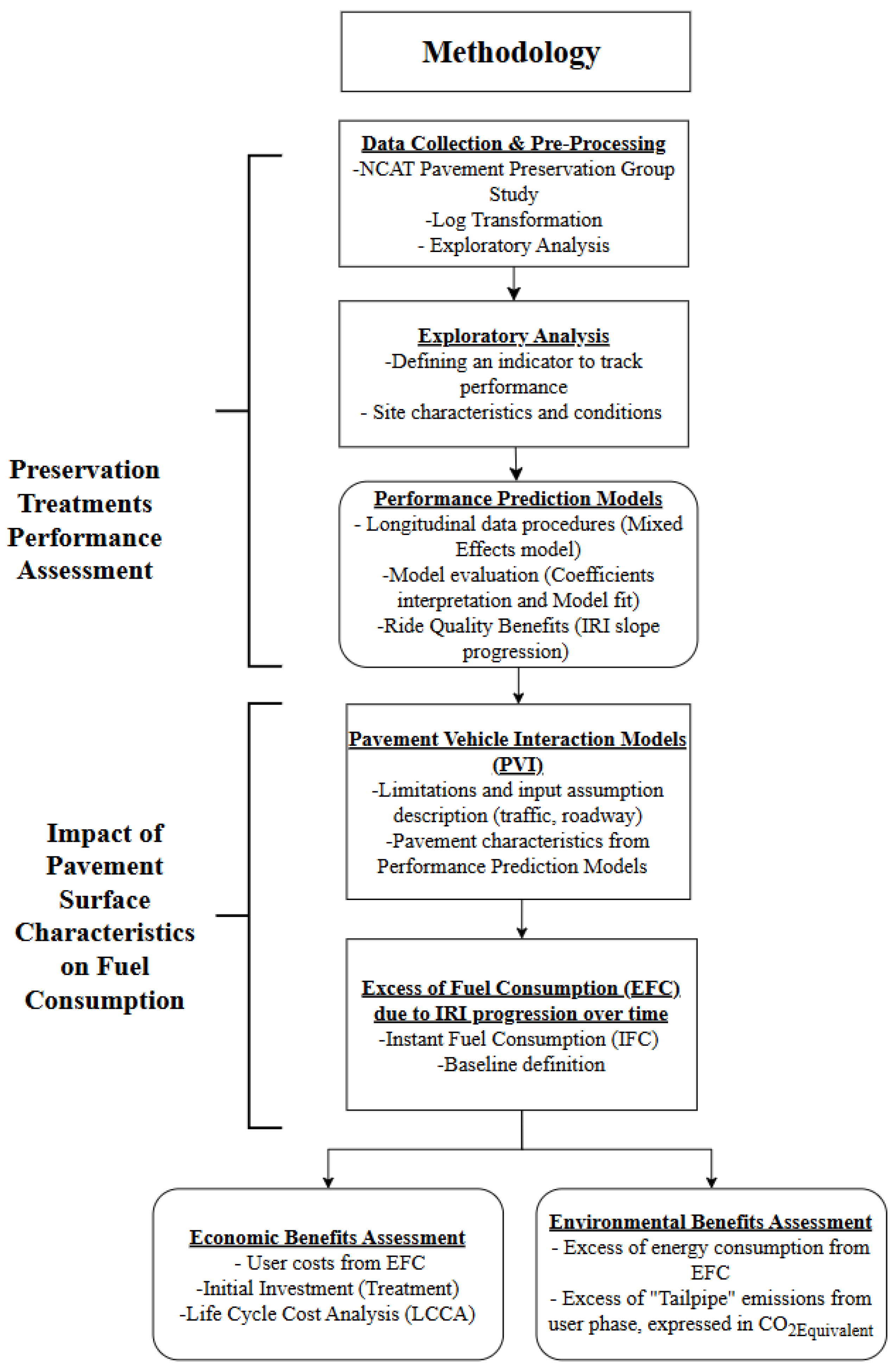

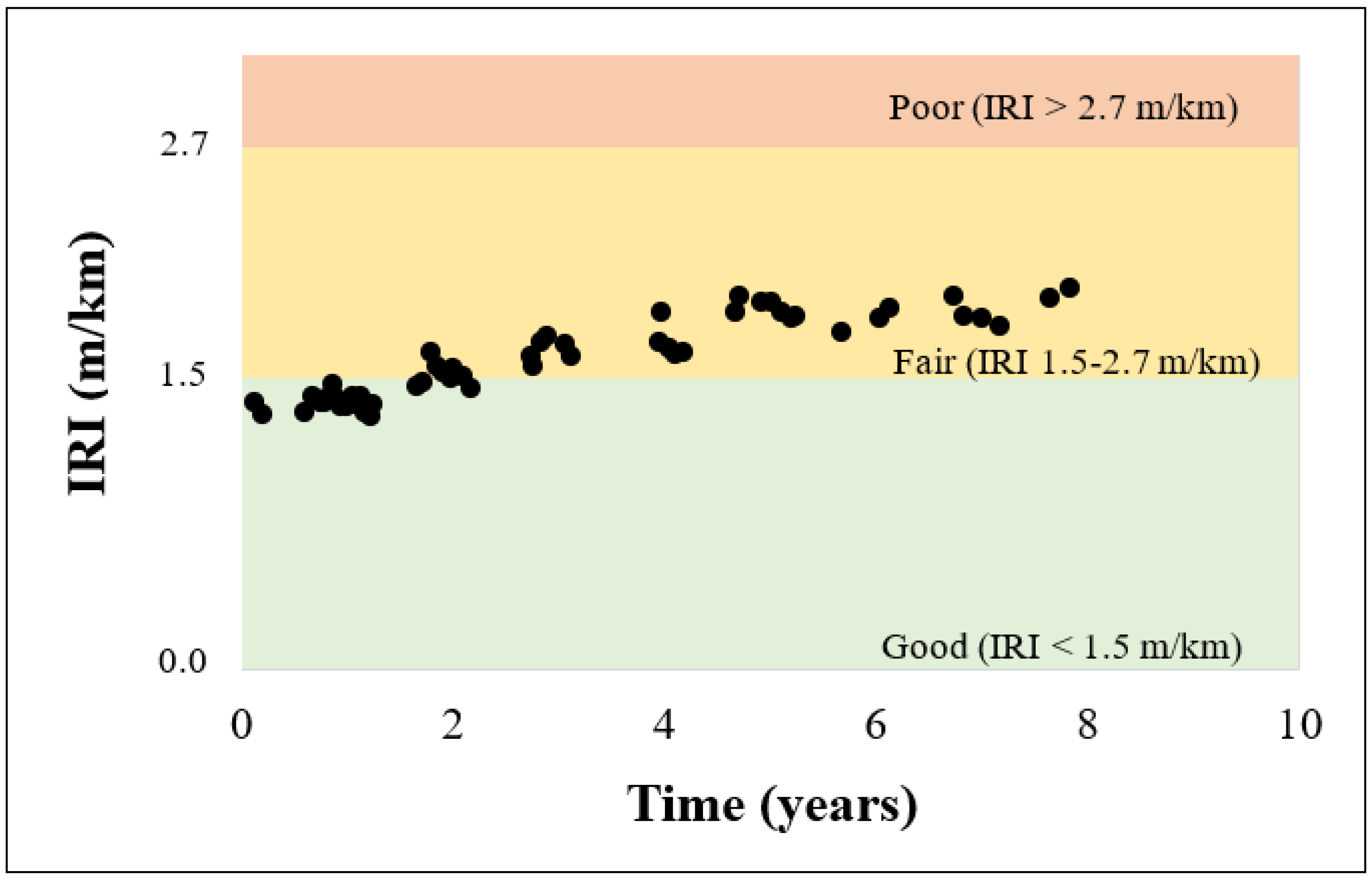


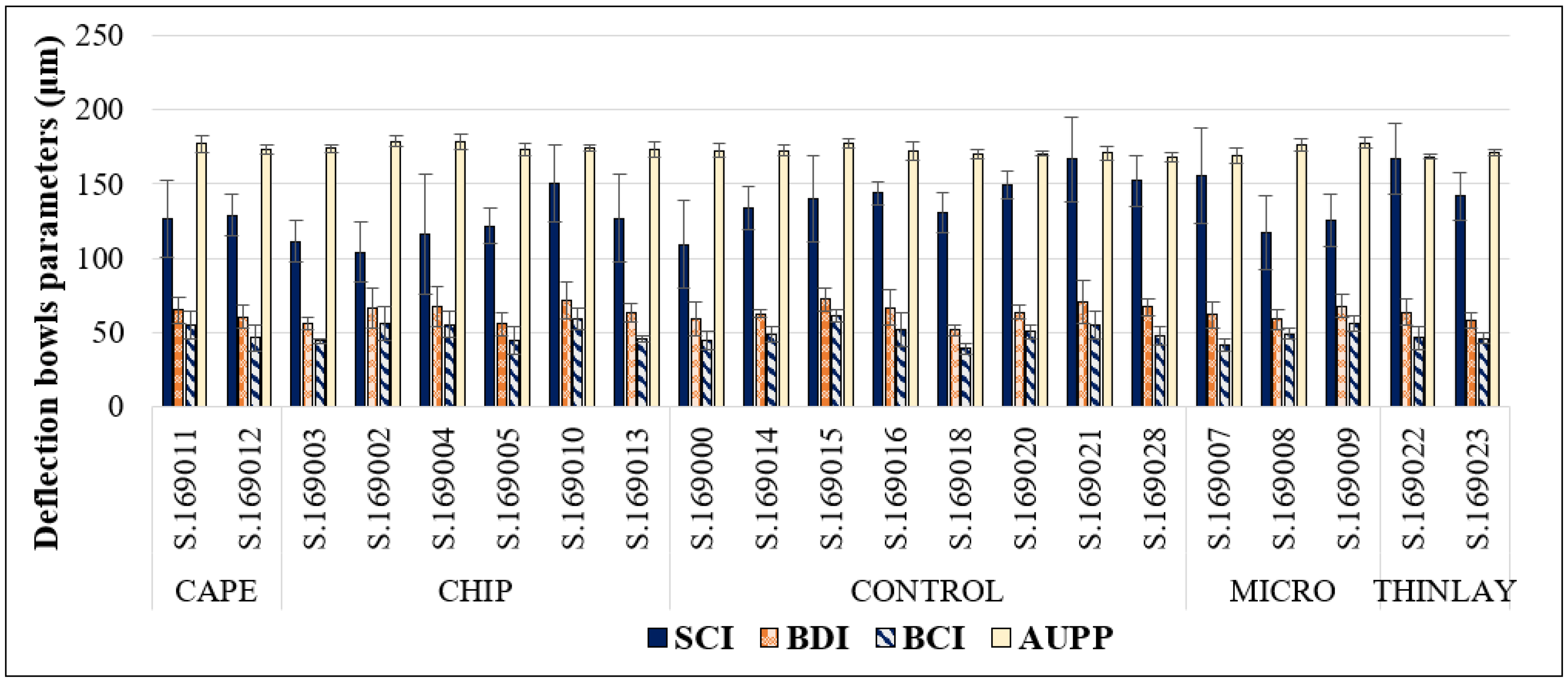


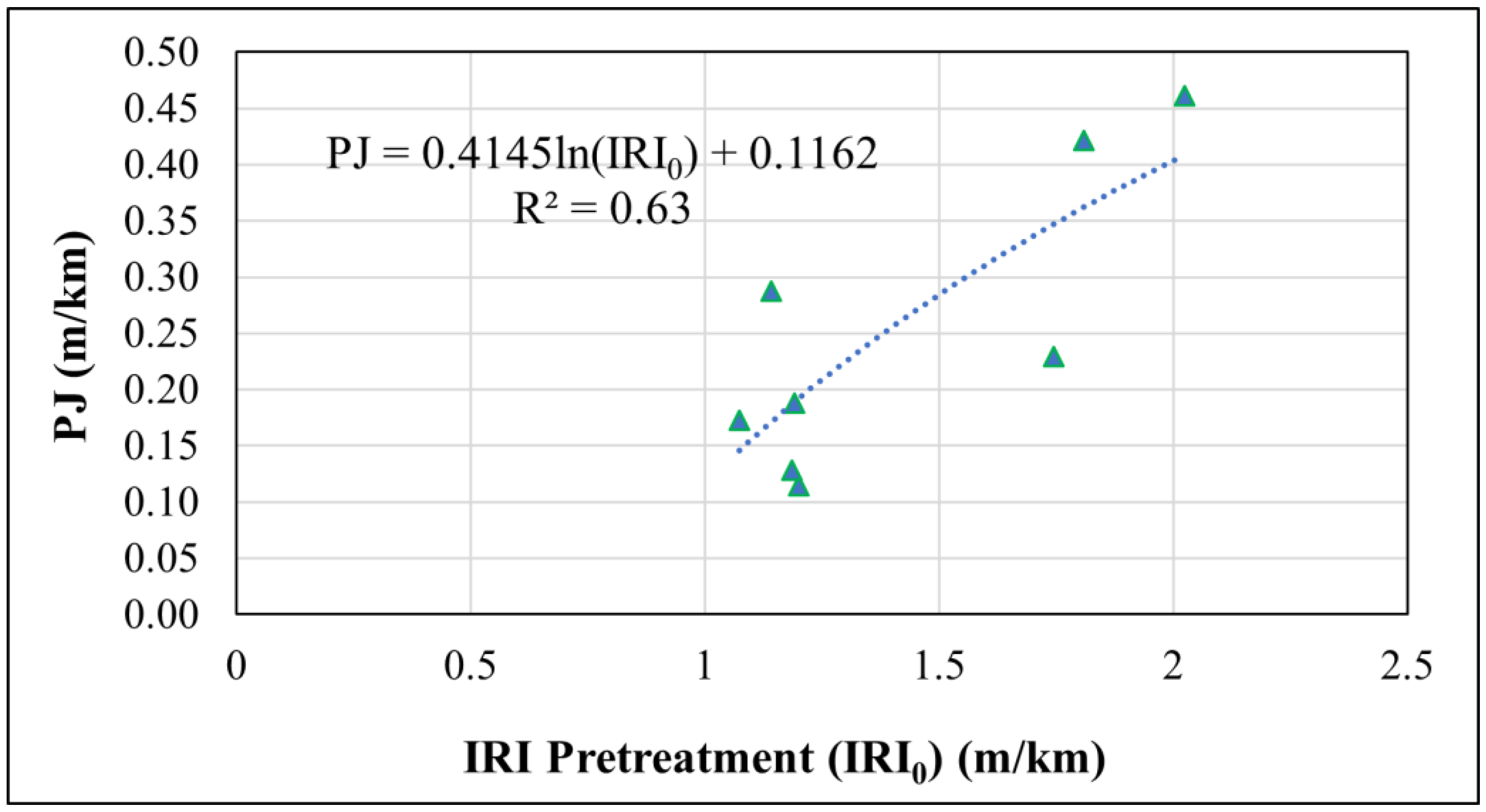
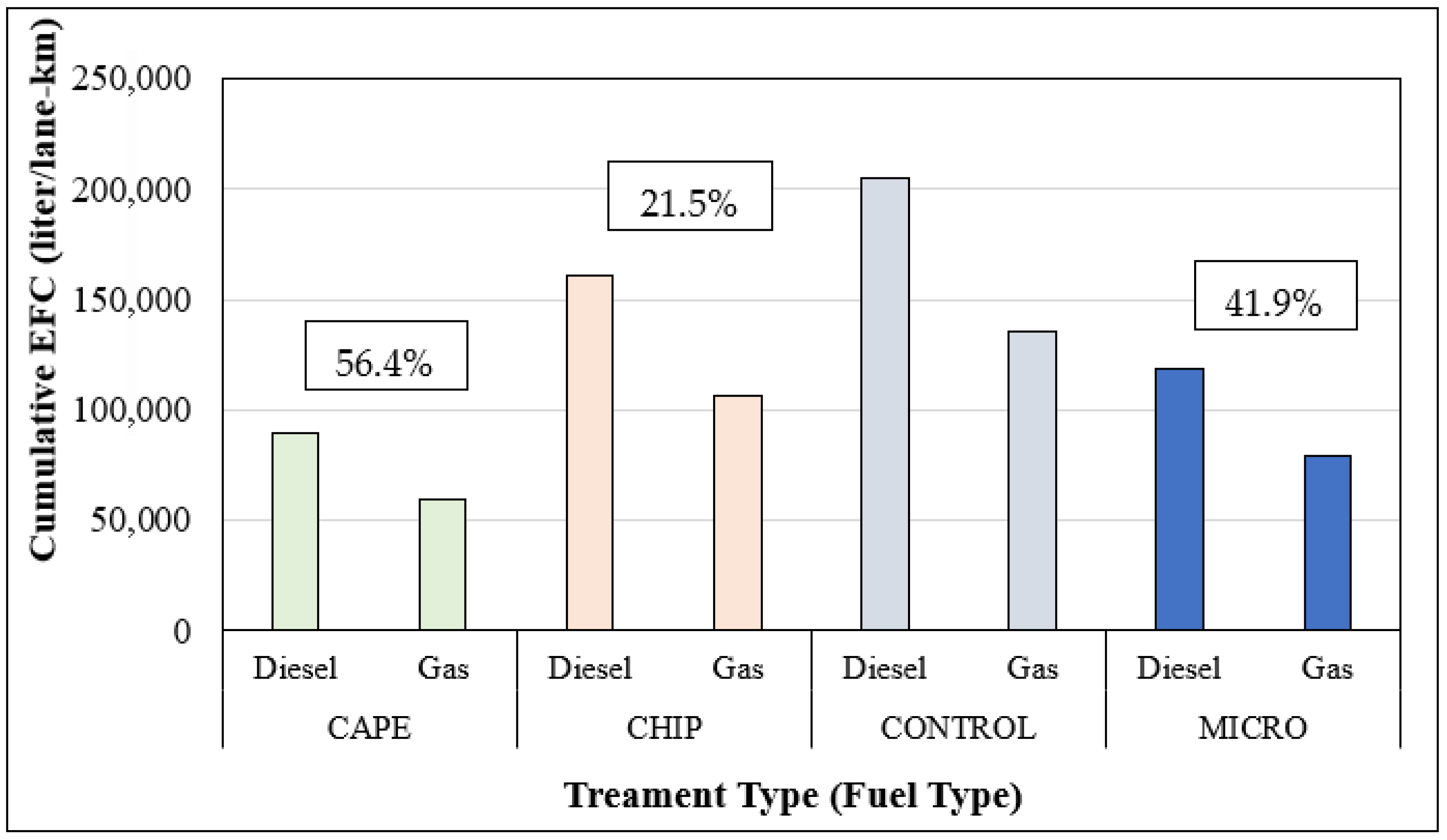



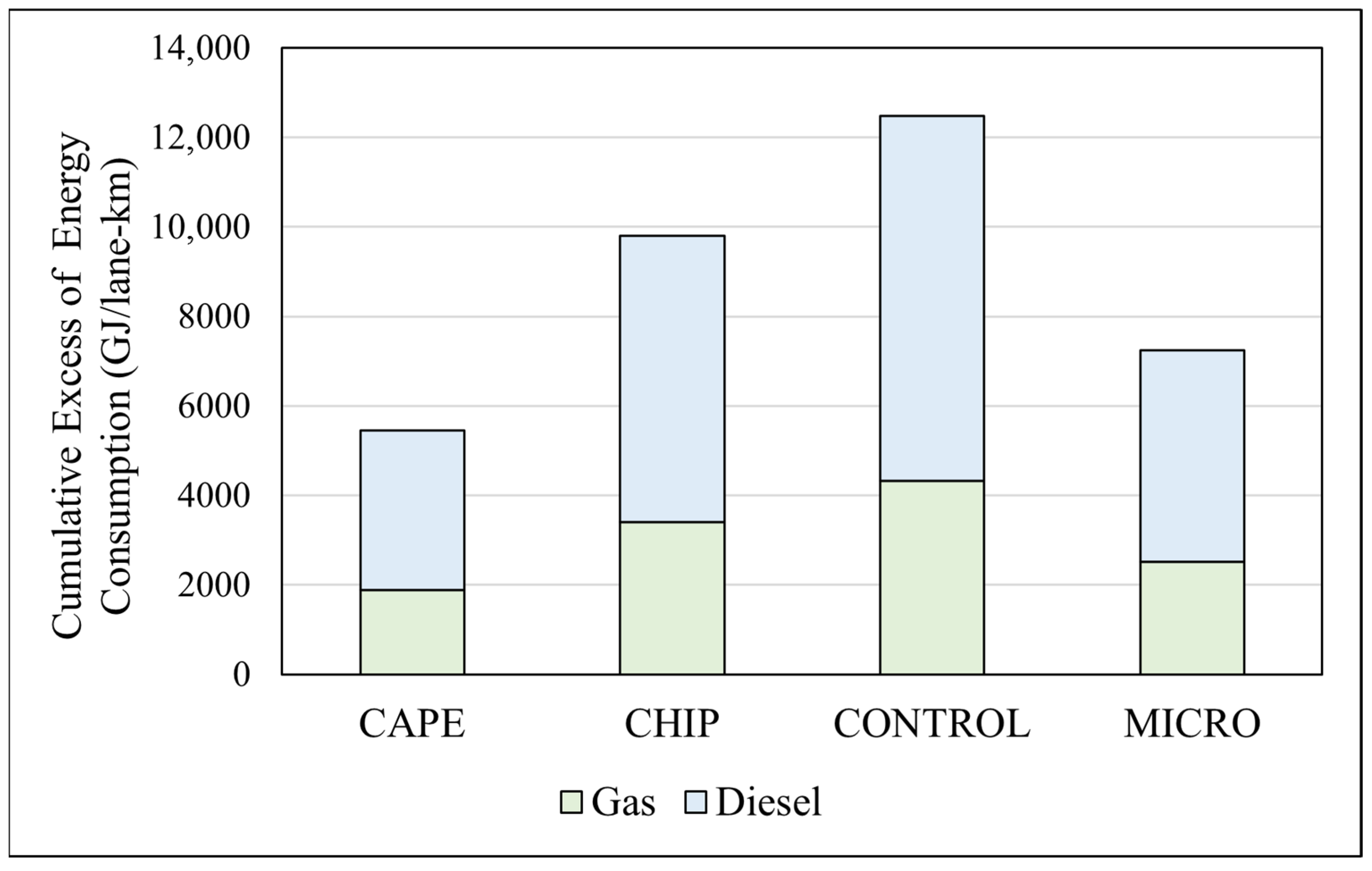
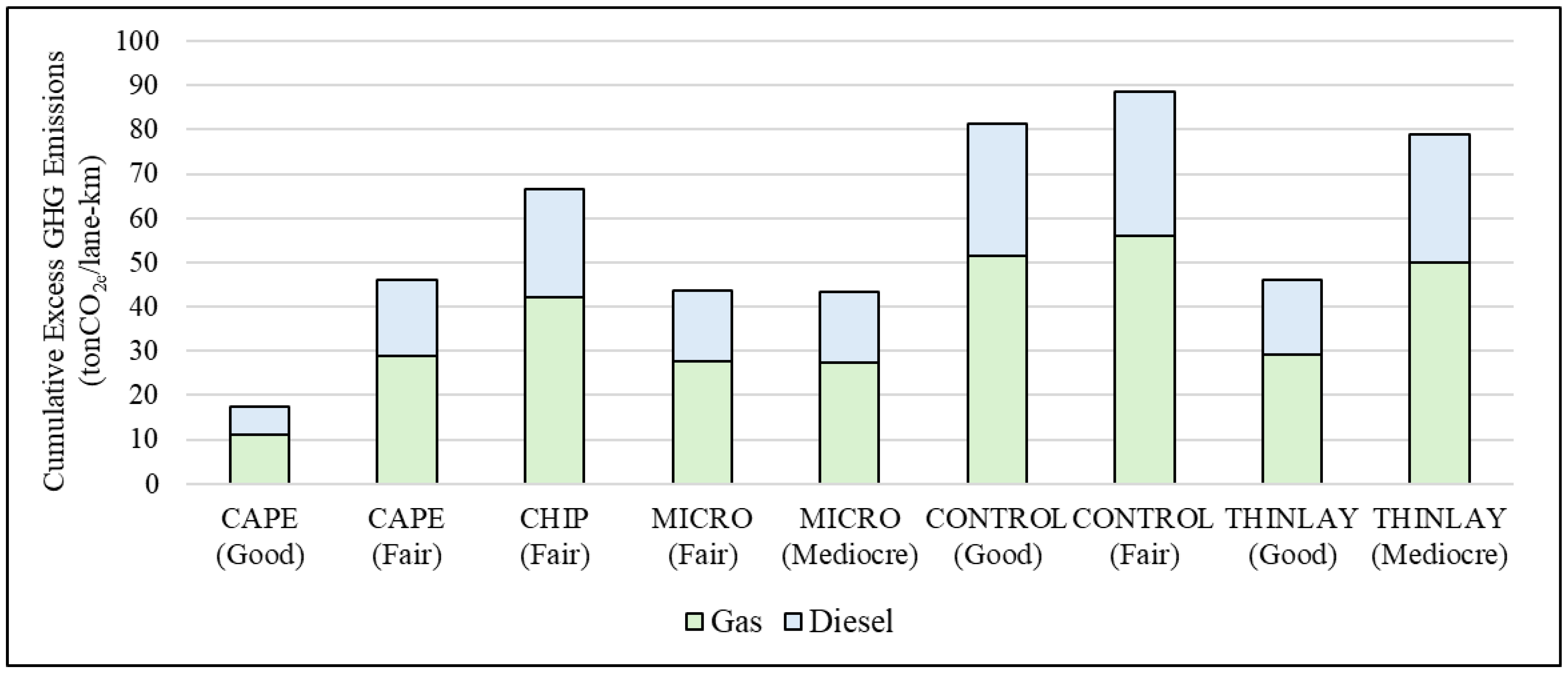
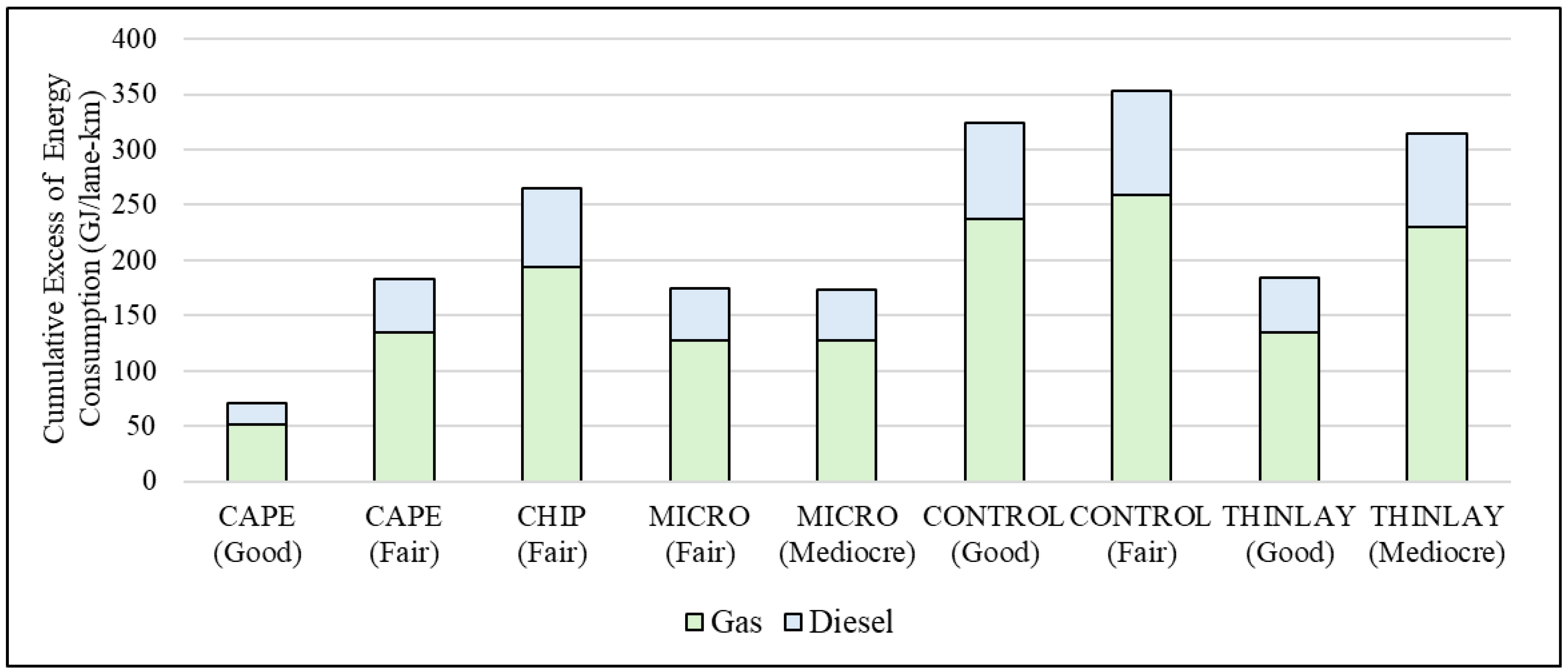
| Section Category | Treatment Description | Wet Freeze | Wet No-Freeze | |
|---|---|---|---|---|
| Low Traffic (CSAH-8) AADT = 510 | High Traffic (US-169) AADT = 16,000 | High Traffic (US-280) AADT = 17,000 | ||
| 2 cm mill + Thinlay (THINLAY) | Mill and asphalt binder replacement (ABR) thinlay | ✓ | ✓ | |
| Mill and ABR thinlay with delta S modifier | ✓ | ✓ | ✓ | |
| Mill and conventional thinlay | ✓ | ✓ | ✓ | |
| Chip Seal (CHIP) | Single-layer chip seal | ✓ | ✓ | ✓ |
| Single-layer chip seal over crack seal | ✓ | ✓ | ✓ | |
| Double-layer chip seal | ✓ | ✓ | ✓ | |
| Triple-layer chip seal | ✓ | ✓ | ✓ | |
| Scrub seal | ✓ | ✓ | ✓ | |
| Single-layer chip seal over fiber membrane | ✓ | ✓ | ✓ | |
| Micro Surfacing (MICRO) | Single-layer micro over crack seal | ✓ | ✓ | ✓ |
| Single-layer micro over | ✓ | ✓ | ✓ | |
| Double-layer micro | ✓ | ✓ | ✓ | |
| Cape Seal (CAPE) | Cape Seal (Single-layer micro over chip seal) | ✓ | ✓ | |
| Fibermat cape seal (Single-layer micro over chip seal over fiber membrane) | ✓ | ✓ | ✓ | |
| Scrub cape seal (Single-layer micro over scrub seal) | ✓ | ✓ | ✓ | |
| Test Parameter | US-280 (No-Freeze) | US-169 (Freeze) |
|---|---|---|
| p-value (95% confidence level) | 0.4633 | 0.0000 |
| Z-statistic | 0.7334 | 7.5947 |
| Kendall Tau Coefficient | 0.0049 | 0.7121 |
| Component | Parameters | Condition Thresholds | ||
|---|---|---|---|---|
| Sound | Warning | Severe | ||
| Structural Component [25] | SCI (μm) | <200 | 200–400 | >400 |
| BDI (μm) | <100 | 100–200 | >200 | |
| BCI (μm) | <50 | 50–100 | >100 | |
| Surface Component [19] | Parameters | Good | Fair | Poor |
| IRI (m/km) | <1.5 | 1.5–2.7 | >2.7 | |
| Cracking (% area) | <5.0 | 5.0–20.0 | >20 | |
| Rut Depth (mm) | <5.0 | 5.0–10.0 | >10.0 | |
| Fixed Effects | Low Traffic Volume | High Traffic Volume |
|---|---|---|
| (SE) | 4.688 (0.082) *** | 4.257 (0.089) *** |
| (SE) | 7.836 × 10−2 (0.008) *** | 3.895 × 10−2 (0.004) *** |
| (SE) | −2.820 × 10−1 (0.019) *** | −1.691 × 10−1 (0.020) *** |
| Random Effects (RE) | Standard Deviation of RE | Standard Deviation of RE |
| 0.314 | 0.303 | |
| 0.031 | 0.013 | |
| Model Performance | ||
| Conditional R2 | 0.93 | 0.94 |
| Marginal R2 | 0.15 | 0.10 |
| Traffic Level | Treatment Group (IRI Pretreatment Condition) | Random Effects Estimate Parameters | |
|---|---|---|---|
| Low Traffic Volume (CSAH–8) | CAPE (Fair) | 0.072 | −0.0720 |
| CAPE (Good) | 0.131 | −0.014 | |
| CHIP (Fair) | 0.125 | −0.018 | |
| MICRO (Fair) | 0.119 | −0.017 | |
| MICRO (Mediocre) | 0.227 | −0.018 | |
| THINLAY (Good) | −0.830 | 0.023 | |
| THINLAY (Mediocre) | −0.466 | 0.067 | |
| CONTROL (Good) | 0.019 | 0.010 | |
| CONTROL (Fair) | 0.241 | 0.010 | |
| High Traffic Volume (US–169) | CAPE (Good) | 0.117 | −0.009 |
| CHIP (Good) | 0.239 | −0.004 | |
| MICRO (Good) | −0.062 | 0.009 | |
| THINLAY (Good) | −0.566 | −0.004 | |
| CONTROL (Good) | 0.078 | 0.017 | |
| Traffic Level | Treatment Group (IRI Pretreatment Condition) | Treatments’ Slopes |
|---|---|---|
| Slope | ||
| Low Traffic Volume (CSAH–8) | CAPE (Fair) | 0.0646 |
| CAPE (Good) | 0.0064 | |
| CHIP (Fair) | 0.0603 | |
| MICRO (Fair) | 0.0609 | |
| MICRO (Mediocre) | 0.0604 | |
| THINLAY (Good) | 0.1010 | |
| THINLAY (Mediocre) | 0.1451 | |
| CONTROL (Good) | 0.0797 | |
| CONTROL (Fair) | 0.0882 | |
| High Traffic Volume (US–169) | CAPE (Good) | 0.0297 |
| CHIP (Good) | 0.0345 | |
| MICRO (Good) | 0.0480 | |
| THINLAY (Good) | 0.0347 | |
| CONTROL (Good) | 0.0556 |
| Treatments (Milling Description) | PJ (m/km) Equation | R2 |
|---|---|---|
| Thinlay (full width pass) * | PJ = k(61.207ln(IRI0/k) − 221.84) | 0.96 |
| Thinlay (8 ft width pass) * | PJ = k(72.307ln(IRI0/k) − 297.96) | 0.89 |
| Micro surfacing and cape seals | PJ = 0.4145ln(IRI0) + 0.1162 | 0.63 |
| Pavement Scenario | EUAC (USD/lane-km) | ||
| Discount Rate | |||
| 3% | 4% | 5% | |
| Alternative 1: (Untreated Pavement Structure) | USD 20,975 | USD 19,718 | USD 18,589 |
| Alternative 2: (Micro surfacing at beginning of analysis period and at year 5) | USD 9441 | USD 8670 | USD 7970 |
| Treatment | Description | GHG Emissions (CO2e ton/lane-km) | Energy Use (GJ/lane-km) |
|---|---|---|---|
| Thinlay (mill + fill) | Data calculated based on an 86 kg/m2 in-place density | 10.9 | 146.0 |
| Micro surfacing | Type II gradation, 14% emulsion, rate: 13 kg/m2 | 0.8 | 17.9 |
| Chip Seal | Emulsion (2.0 L/m2) and aggregate (8.7 kg/m2) | 1.8 | 32.5 |
| Cape Seal | Chip seal + micro surfacing | 2.9 | 55.9 |
| Unit | Activity | Alternative 1 | Alternative 2 |
|---|---|---|---|
| GHG Emissions (CO2e ton/lane-km) | Excess GHG (Trucks) | 954.4 | 363.1 |
| Excess GHG (Cars) | 492.2 | 187.4 | |
| Road Preservation | NA | 1.6 | |
| Energy (GJ/lane-km) | Excess Energy (Trucks) | 696.1 | 421.9 |
| Excess Energy (Cars) | 370.3 | 224.6 | |
| Road Preservation | NA | 35.8 |
Disclaimer/Publisher’s Note: The statements, opinions and data contained in all publications are solely those of the individual author(s) and contributor(s) and not of MDPI and/or the editor(s). MDPI and/or the editor(s) disclaim responsibility for any injury to people or property resulting from any ideas, methods, instructions or products referred to in the content. |
© 2025 by the authors. Licensee MDPI, Basel, Switzerland. This article is an open access article distributed under the terms and conditions of the Creative Commons Attribution (CC BY) license (https://creativecommons.org/licenses/by/4.0/).
Share and Cite
Brenes-Calderon, A.; Vargas-Nordcbeck, A.; Gatiganti, S.C.; Garita-Jimenez, J. Determining Performance, Economic, and Environmental Benefits of Pavement Preservation Treatments: Results from a Systematic Framework for PMS. Constr. Mater. 2025, 5, 66. https://doi.org/10.3390/constrmater5030066
Brenes-Calderon A, Vargas-Nordcbeck A, Gatiganti SC, Garita-Jimenez J. Determining Performance, Economic, and Environmental Benefits of Pavement Preservation Treatments: Results from a Systematic Framework for PMS. Construction Materials. 2025; 5(3):66. https://doi.org/10.3390/constrmater5030066
Chicago/Turabian StyleBrenes-Calderon, Anthony, Adriana Vargas-Nordcbeck, Surendra Chowdari Gatiganti, and Josué Garita-Jimenez. 2025. "Determining Performance, Economic, and Environmental Benefits of Pavement Preservation Treatments: Results from a Systematic Framework for PMS" Construction Materials 5, no. 3: 66. https://doi.org/10.3390/constrmater5030066
APA StyleBrenes-Calderon, A., Vargas-Nordcbeck, A., Gatiganti, S. C., & Garita-Jimenez, J. (2025). Determining Performance, Economic, and Environmental Benefits of Pavement Preservation Treatments: Results from a Systematic Framework for PMS. Construction Materials, 5(3), 66. https://doi.org/10.3390/constrmater5030066





